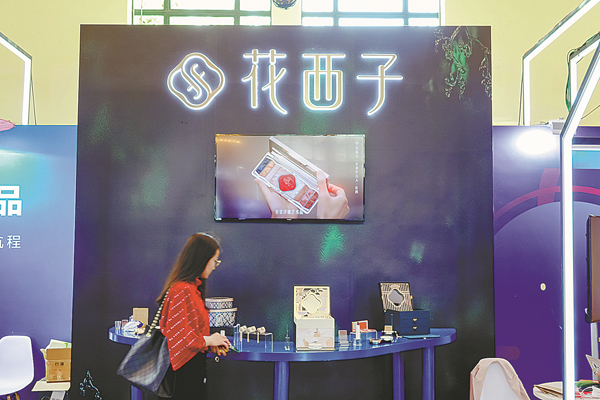Domestic brands rapidly raising their game

Cosmetic brand Florasis.
Product ranges feature elements inspired by traditional Chinese culture
Facing fierce competition in the booming domestic market, newly emerged Chinese brands are keen to drive their transformation by strengthening efforts to meet consumer demand and develop their goods.
In the past decade, products made in China have made their mark in the domestic market and are no longer viewed as being cheap or inferior to foreign brands.
Florasis, a Chinese cosmetics company that has gained popularity among Chinese and overseas consumers in the past five years, is a good example of the makeover that has taken place among Chinese brands.
The company was launched in 2017 in Hangzhou, capital of Zhejiang province, with the aim of reviving traditional Chinese aesthetics and cultural practices. It has since launched a series of signature products, including its etched lipsticks and loose powder containing floral infusions and Chinese herbs.
Meng Huo, vice-president of Florasis, said, "The company targets female Asian consumers with a variety of cosmetics to suit their skin, match their preferences with medium- and high-end goods, and catch their attention with elements inspired by traditional Chinese culture."
In 2020, Florasis launched a set of lipsticks to celebrate Chinese Valentine's Day. The lipsticks, designed in the shape of a lovelock-a symbol of enduring love throughout Chinese history-feature the romantic story of Zhang Bi, an official in the Western Han Dynasty (206 BC-AD 24) who drew eyebrows for his wife and designs on her lips that symbolized China.
Today, members of the new generation of consumers want items that reflect their culture, rather than the foreign heritage and exclusivity that have been so popular in the past. Such demand has resulted in the emergence of the guochao trend-the rise of domestic marques that include Chinese cultural elements in their design or branding.
Meng said, "We want to create a brand that embraces the balance of art, nature and science through our traditional recipes-infusing them in modern formulations using the latest research and development technologies."
Florasis keeps in direct touch with consumers through its livestreaming room and other online platforms, not only to sell products, but to learn the type of products that consumers are looking for. The company's Florasis GEM Program works in conjunction with 200,000 consumers, who help choose the right items to market.
"It usually takes about 21 months to complete the research and development of a single item, which has to pass tests among at least 1,000 product testers before it can be put on the market," Meng said.
Florasis' total transactions reached more than 100 million yuan ($14.79 million) just one year after the opening of its Tmall flagship store in August 2017. Last year, the brand's gross merchandise volume rose to 5.4 billion yuan, up from 3.3 billion yuan in 2020.
After experiencing rapid growth, Florasis' main goal now is to develop the quality of its existing products through in-depth research, instead of promoting a range of new items.
In March, Florasis launched China's first CMF (color, material and finish) laboratory in the cosmetics industry to focus on researching the use of sustainable materials, the relationship between female skin characteristics and makeup color, as well as color trends in Chinese fashion.
In 2019, Florasis began planning its overseas market due to increased demand from consumers living abroad for products that feature Chinese culture. The brand entered the Japanese market in March last year, and two months later, it launched its global website.
In January, Florasis released part of a makeup series that features the 24 solar terms on the traditional Chinese calendar. The series highlights Chinese makeup characteristics such as thin and long eyebrows, under-eye makeup and cherry lips, integrating the different solar terms and floral characteristics into the makeup by combining the shape and color of flowers.
"Our growing popularity overseas has given us the confidence to continue our research and development of products that feature unique Chinese culture in their design and raw materials," Meng said.
-
Visionary Pathway - Hangzhou Playbook
July 15, 2025



